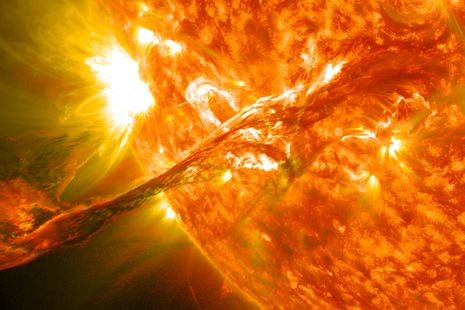Research Roundup: Week 9
Teymour Taj explains some tantalising recent research ranging from tiny insect brains to astronomically-sized stars

The Sun’s magnetic field may not originate as deep as first thought
The Sun’s magnetic field is responsible for the stream of charged particles which cause the Northern Lights, as well as the ‘solar flares’ often forming the plot of sci-fi films.
Previous theories indicated that the Sun’s magnetic field was generated at the bottom of a 130 000-mile deep ‘ocean’, known as the tachocline region. The tachocline marks the boundary between the outer layer of the sun with rotating convection currents and the calmer interior. At the boundary, there is strong ‘stretching’ of fluid in the sun and a jump in solar windspeed that can amplify the Sun’s magnetic field. Unfortunately, this disagrees with studies of the structure of the Sun, which point to a much shallower origin.
However, new research suggests that the field originates just 20 000 miles below the surface. A team led by Geoffrey Vasil at the University of Edinburgh created a model which shows that the magnetic field is generated by a process called magnetorotational instability, relating to unstable rotations of fluid just below the surface. The new model better matches observations of the oscillations of the Sun’s magnetic field, and could help us better understand sunspots which pose a risk to electronic equipment on Earth.
Cloud geoengineering could make Europe bask
“MCB could also significantly increase heat stress in Europe, leading to even hotter summers than forecast with the current rate of global warming”
The engineering of clouds to make them brighter and more reflective has been proposed as a way to cool atmospheric temperatures and slow the effects of climate change. This strategy is known as marine cloud brightening (MCB). However, recent research has found that the use of MCB in America may have some unintended consequences for us over in Europe.
While the model found that this technology would reduce the risk of dangerous heatwaves in the Western United States, it could also significantly increase heat stress in Europe, leading to even hotter summers than forecast with the current rate of global warming. In addition, rainfall would be reduced as far as the Sahara Desert. This is thought to be due to the MCB-induced climate changes disrupting atmospheric circulation currents, and is a stark reminder that purely using technology to fight climate change is a high-risk strategy.
Are flies really so dumb?
When watching a fly in your bedroom buzz towards a grisly death in your ceiling light, you probably won’t be thinking very highly of the creature’s intelligence. However, as Elizabeth Barsotti of the MRC Laboratory of Molecular Biology in Cambridge explains, they are smarter than we think.
Barsotti’s team published the first-ever map of the synapses of fruit fly larvae, which showed that these flies have connections responsible for learning, memory and direction that were previously thought to be unique to humans. Her team is hoping to map dozens of animal brains in a similar way, in order to produce a general brain map which holds for all species. This could revolutionise treatment of neurological diseases, and aid the development of AI technologies.
 News / Clare Hall spent over £500k opposing busway 24 December 2025
News / Clare Hall spent over £500k opposing busway 24 December 2025 Comment / The ‘class’ of Cambridge24 December 2025
Comment / The ‘class’ of Cambridge24 December 2025 News / Caius mourns its tree-mendous loss23 December 2025
News / Caius mourns its tree-mendous loss23 December 2025 News / Girton JCR publishes open letter expressing solidarity with Palestine25 December 2025
News / Girton JCR publishes open letter expressing solidarity with Palestine25 December 2025 Comment / Yes, I’m brown – but I have more important things to say22 December 2025
Comment / Yes, I’m brown – but I have more important things to say22 December 2025










